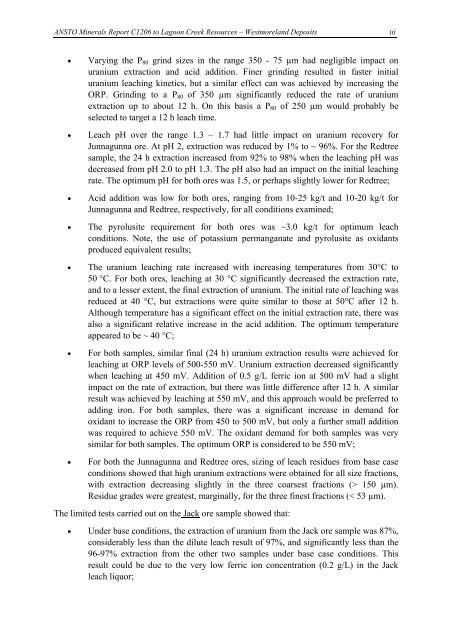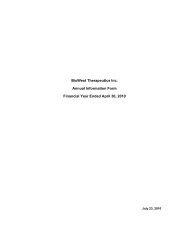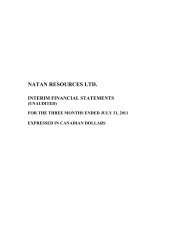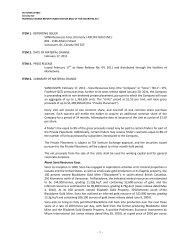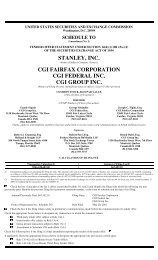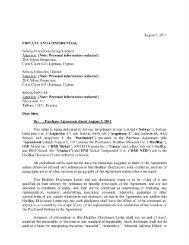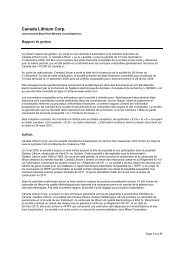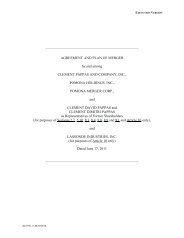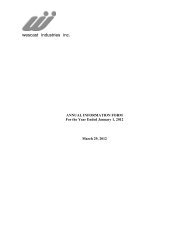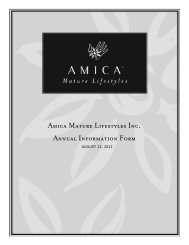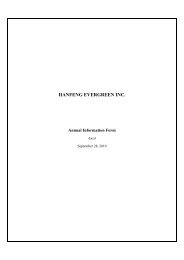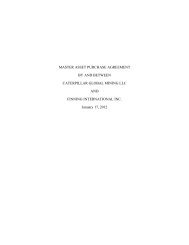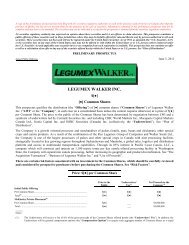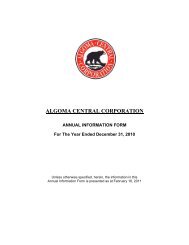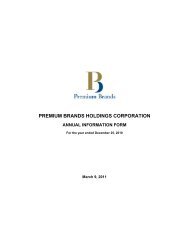Laterite Leach Tests
Laterite Leach Tests
Laterite Leach Tests
Create successful ePaper yourself
Turn your PDF publications into a flip-book with our unique Google optimized e-Paper software.
ANSTO Minerals Report C1206 to Lagoon Creek Resources – Westmoreland Deposits iii<br />
• Varying the P80 grind sizes in the range 350 - 75 µm had negligible impact on<br />
uranium extraction and acid addition. Finer grinding resulted in faster initial<br />
uranium leaching kinetics, but a similar effect can was achieved by increasing the<br />
ORP. Grinding to a P80 of 350 µm significantly reduced the rate of uranium<br />
extraction up to about 12 h. On this basis a P80 of 250 µm would probably be<br />
selected to target a 12 h leach time.<br />
• <strong>Leach</strong> pH over the range 1.3 – 1.7 had little impact on uranium recovery for<br />
Junnagunna ore. At pH 2, extraction was reduced by 1% to ~ 96%. For the Redtree<br />
sample, the 24 h extraction increased from 92% to 98% when the leaching pH was<br />
decreased from pH 2.0 to pH 1.3. The pH also had an impact on the initial leaching<br />
rate. The optimum pH for both ores was 1.5, or perhaps slightly lower for Redtree;<br />
• Acid addition was low for both ores, ranging from 10-25 kg/t and 10-20 kg/t for<br />
Junnagunna and Redtree, respectively, for all conditions examined;<br />
• The pyrolusite requirement for both ores was ~3.0 kg/t for optimum leach<br />
conditions. Note, the use of potassium permanganate and pyrolusite as oxidants<br />
produced equivalent results;<br />
• The uranium leaching rate increased with increasing temperatures from 30°C to<br />
50 °C. For both ores, leaching at 30 °C significantly decreased the extraction rate,<br />
and to a lesser extent, the final extraction of uranium. The initial rate of leaching was<br />
reduced at 40 °C, but extractions were quite similar to those at 50°C after 12 h.<br />
Although temperature has a significant effect on the initial extraction rate, there was<br />
also a significant relative increase in the acid addition. The optimum temperature<br />
appeared to be ~ 40 °C;<br />
• For both samples, similar final (24 h) uranium extraction results were achieved for<br />
leaching at ORP levels of 500-550 mV. Uranium extraction decreased significantly<br />
when leaching at 450 mV. Addition of 0.5 g/L ferric ion at 500 mV had a slight<br />
impact on the rate of extraction, but there was little difference after 12 h. A similar<br />
result was achieved by leaching at 550 mV, and this approach would be preferred to<br />
adding iron. For both samples, there was a significant increase in demand for<br />
oxidant to increase the ORP from 450 to 500 mV, but only a further small addition<br />
was required to achieve 550 mV. The oxidant demand for both samples was very<br />
similar for both samples. The optimum ORP is considered to be 550 mV;<br />
• For both the Junnagunna and Redtree ores, sizing of leach residues from base case<br />
conditions showed that high uranium extractions were obtained for all size fractions,<br />
with extraction decreasing slightly in the three coarsest fractions (> 150 µm).<br />
Residue grades were greatest, marginally, for the three finest fractions (< 53 µm).<br />
The limited tests carried out on the Jack ore sample showed that:<br />
• Under base conditions, the extraction of uranium from the Jack ore sample was 87%,<br />
considerably less than the dilute leach result of 97%, and significantly less than the<br />
96-97% extraction from the other two samples under base case conditions. This<br />
result could be due to the very low ferric ion concentration (0.2 g/L) in the Jack<br />
leach liquor;


